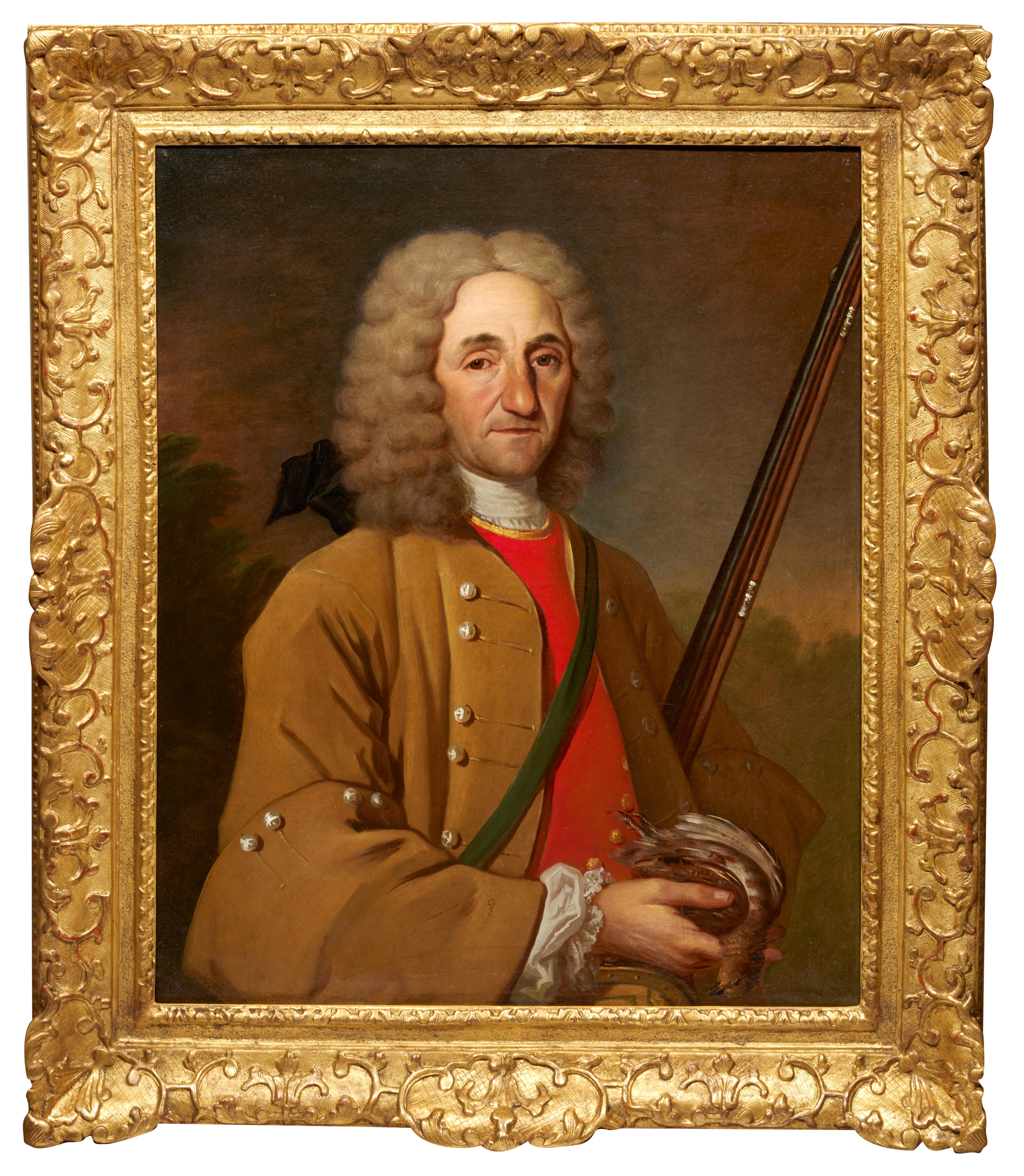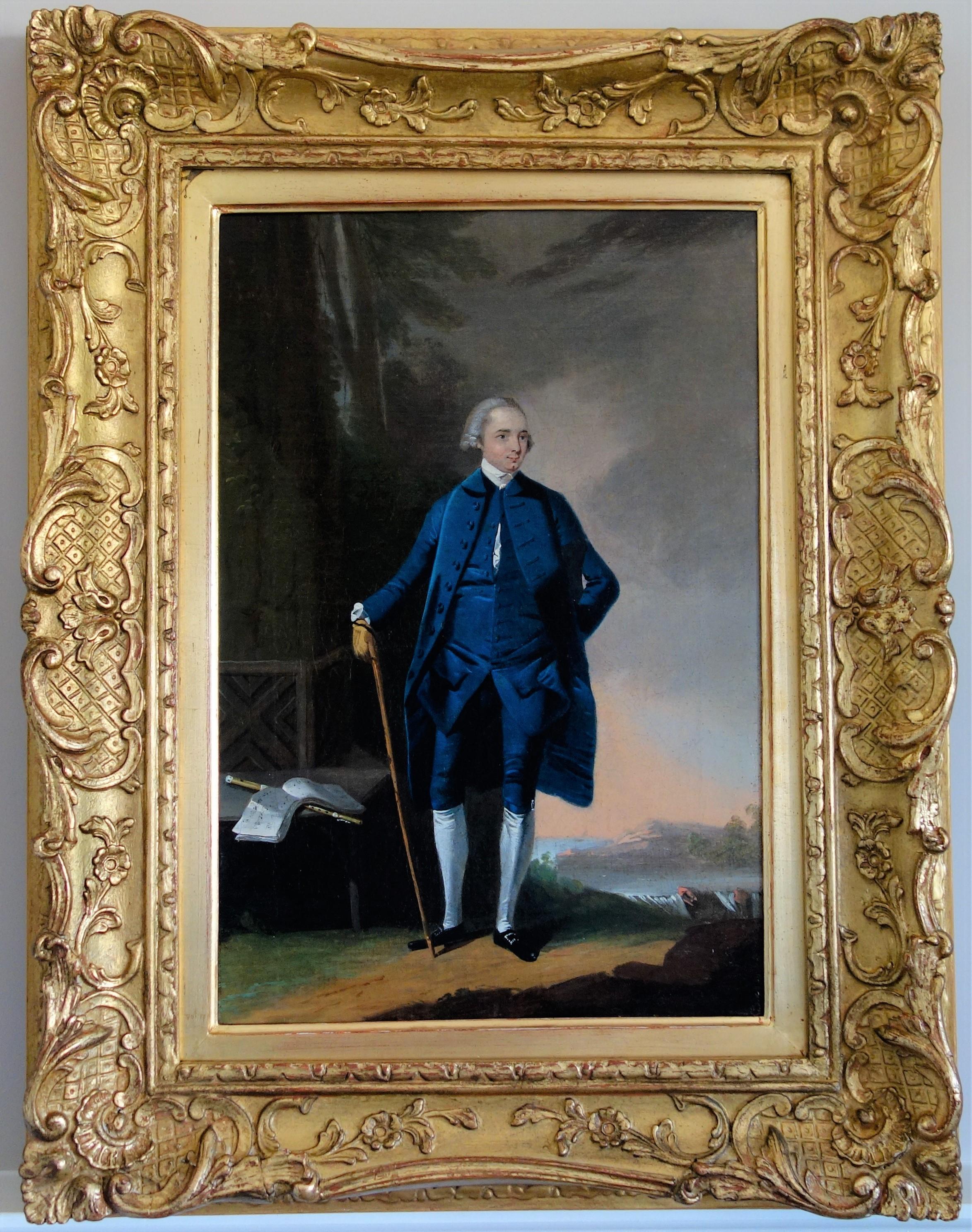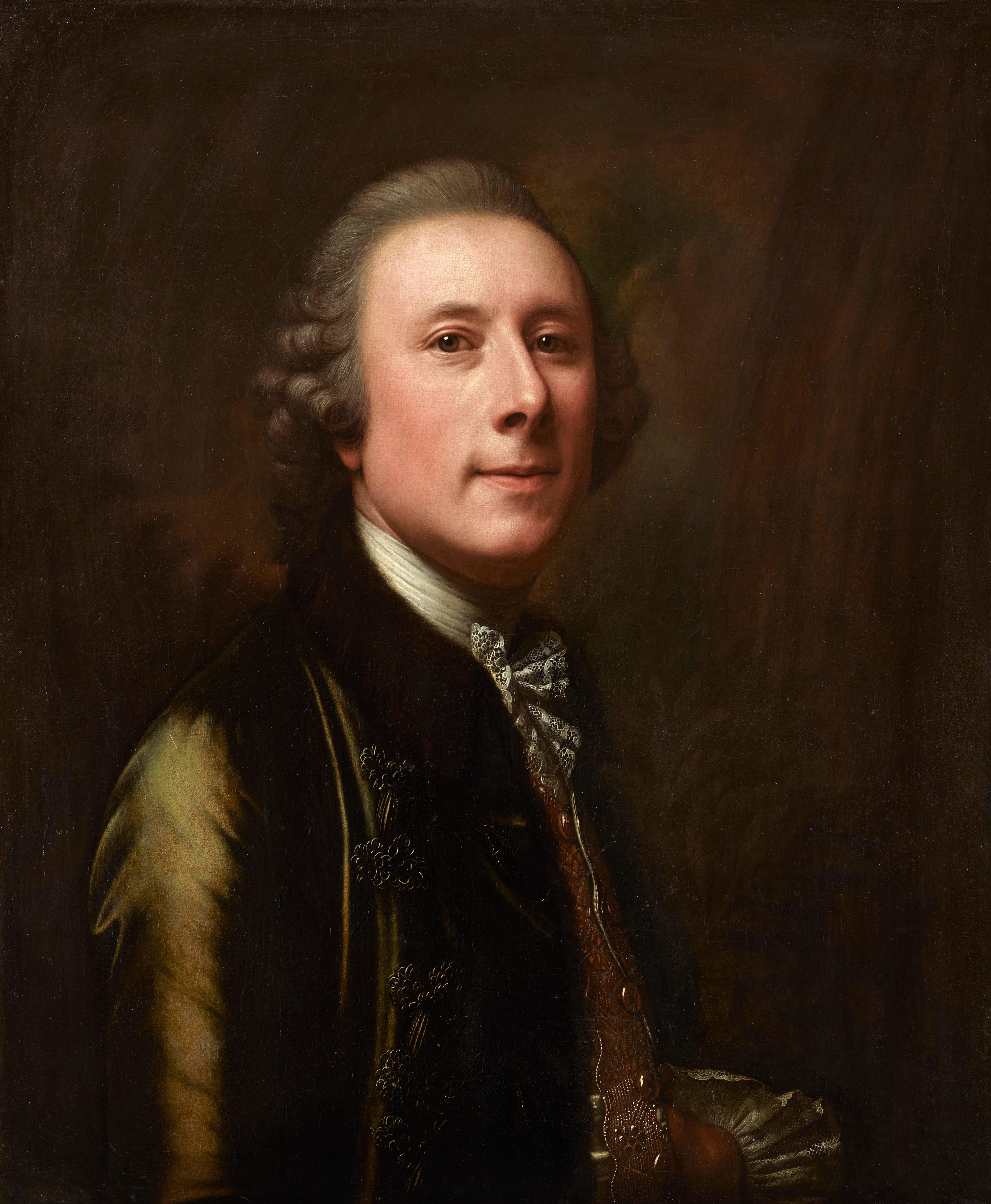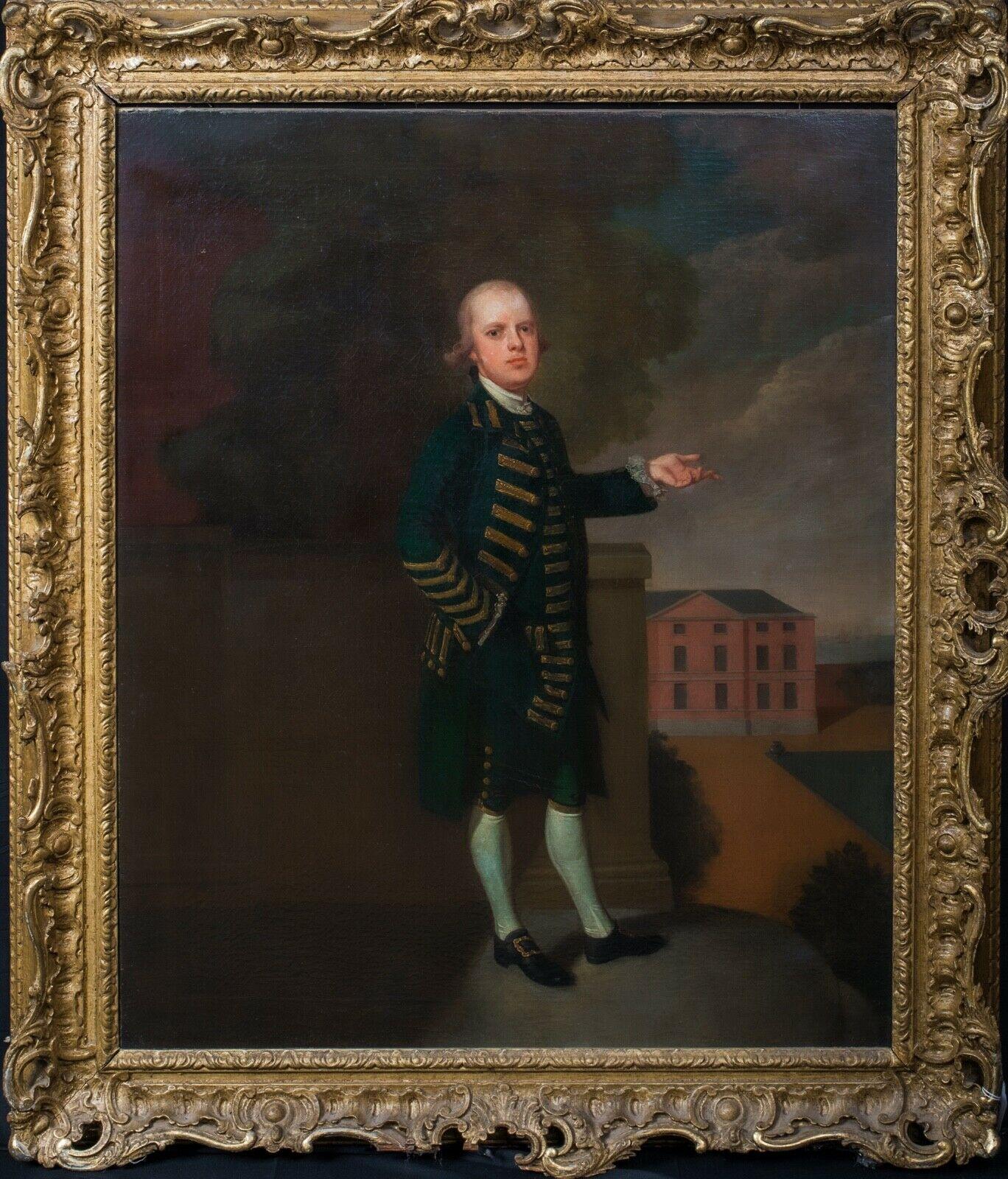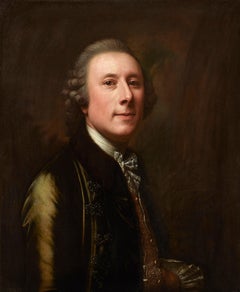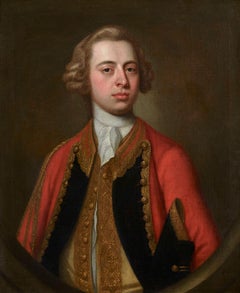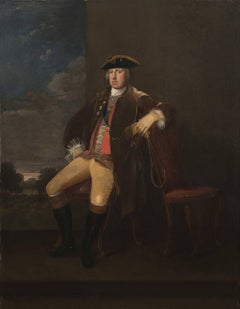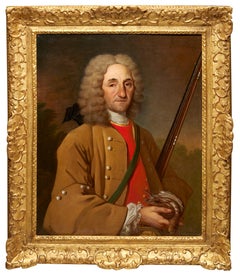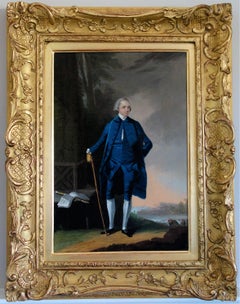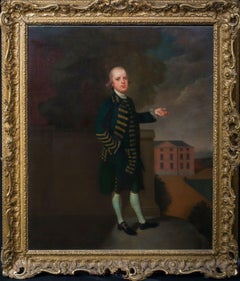Items Similar to Portrait of a Man with a Rifle
Want more images or videos?
Request additional images or videos from the seller
1 of 3
English school 18th centuryPortrait of a Man with a Rifle
$6,434.04
£4,600
€5,493.41
CA$8,801.64
A$9,849.28
CHF 5,142.83
MX$121,086.70
NOK 64,882.77
SEK 61,054.37
DKK 40,985.01
Shipping
Retrieving quote...The 1stDibs Promise:
Authenticity Guarantee,
Money-Back Guarantee,
24-Hour Cancellation
About the Item
Oil on layered paper
Image size: 10 1/2 x 8 1/4 inches (26.5 x 21 cm)
Contemporary swept frame
This is an eighteenth century portrait of a man dressed as a hunter, holding a flintlock rifle under his elbow. The subject, standing three-quarter length is presented wearing the fashion of the second half of the 18th century, including a large green coloured jacket decorated with gold trim and gold buttons.
The jacket opens onto a vermillion waistcoat and a brown shoulder strap probably holds a powder flask hidden under his arm. The man's long hair is held back with a black ribbon. He stands out against a dark sky at the end of a day in a soberly sketched forest landscape.
Eighteenth century paintings invariably associated hunting with class privilege and social hierarchy. It was in the 18th century that hunting was put on as an organised and commercial basis - hunting clubs were set up as paying propositions, with uniforms and an emphasis on genteel networking. Hunting enthusiasts in the 18th and 19th century Britain often documented this ritual of the elite through the means of paintings.
- Creator:English school 18th century
- Dimensions:Height: 1.5 in (3.81 cm)Width: 8 in (20.32 cm)
- More Editions & Sizes:1 of 1Price: $6,434
- Medium:
- Movement & Style:
- Period:
- Condition:
- Gallery Location:London, GB
- Reference Number:1stDibs: LU52412052752
About the Seller
5.0
Vetted Professional Seller
Every seller passes strict standards for authenticity and reliability
Established in 2007
1stDibs seller since 2014
81 sales on 1stDibs
Typical response time: 3 hours
- ShippingRetrieving quote...Shipping from: London, United Kingdom
- Return Policy
Authenticity Guarantee
In the unlikely event there’s an issue with an item’s authenticity, contact us within 1 year for a full refund. DetailsMoney-Back Guarantee
If your item is not as described, is damaged in transit, or does not arrive, contact us within 7 days for a full refund. Details24-Hour Cancellation
You have a 24-hour grace period in which to reconsider your purchase, with no questions asked.Vetted Professional Sellers
Our world-class sellers must adhere to strict standards for service and quality, maintaining the integrity of our listings.Price-Match Guarantee
If you find that a seller listed the same item for a lower price elsewhere, we’ll match it.Trusted Global Delivery
Our best-in-class carrier network provides specialized shipping options worldwide, including custom delivery.More From This Seller
View AllPortrait of a Gentleman, 18th Century Oil Painting
By Anton von Maron
Located in London, GB
Oil on canvas
Image size: 20 x 24 inches (51 x 61 cm)
Period gilt frame
This is a half-length portrait of a gentleman wearing a emerald coat and intricately designed waistcoat, dat...
Category
1760s Portrait Paintings
Materials
Canvas, Oil
Portrait of William Henry Kerr, Earl of Ancram, 4th Marquess of Lothian
Located in London, GB
James Fellowes
Flourished 1719 - 1750
Portrait of William Henry Kerr, Earl of Ancram, 4th Marquess of Lothian
Oil on canvas, signed & dated 1747
Image size: 29 1/2 x 24 1/2 inches (75 x 62 cm)
Original gilt wood frame
William Henry Kerr was born a member of the Scottish peerage to William, third Marquess of Lothian, and his first wife Margaret, daughter of Sir Thomas Nicholson of Kemnay, first Baronet. William was styled Master Jedburgh until 1722, when his father was elevated to a Marquessate, after which he was referred to as Lord Jedburgh until 1735. Following his father’s military footsteps, on 20 June 1735 Ancram was commissioned as a cornet to the regiment (11th Dragoons) of his grand-uncle, Lord Mark Kerr. Ancram married Lady Caroline...
Category
1740s Old Masters Portrait Paintings
Materials
Oil
Portrait of a King's Messenger, 18th Century English Artist, Original Frame
By Charles Philips
Located in London, GB
Charles Philips
1703 - 1747
Portrait of a King's Messenger
Oil on canvas
Image size: 35 ¾ x 28 inches
Original gilt frame
King's Messenger
The job of a King's Messenger was that of a diplomatic courier, hand-carrying important and secret documents around the world. Some say that the history of the sovereigns' messengers goes back to 1199, but the first known messenger was John Norman, who in 1485 earned 4d (1½ pence) per day for carrying the state papers of Richard III.
The silver greyhound on the messenger's badge dates back to Charles II. In 1660, during his exile at Breda, Netherlands, Charles II issued a declaration of amnesty to all those who had opposed him and his father. He used messengers to make his intentions known. In answer to the messenger's question "How will they know me?", Charles reached forward to a silver bowl on the table in front of him. This bowl, with four decorative greyhounds standing proud above the rim, was well known to all courtiers. Charles broke off a greyhound and gave it to the messenger as a guarantee that the message came from him. From that date, the King's Messenger always wore a silver greyhound around his neck.
Later, dating from George II or III, a badge with the Royal Arms in enamel, with the greyhound suspended beneath, was worn. A George III example of the King's Messenger Badge, pre 1800, sold for over £30,000 pounds some years ago.
The silver greyhounds were minted for each new reign, except the brief one of King Edward VIII. The sovereign's messengers were originally controlled by the Lord Chamberlain, being Messengers of the Great Chamber. When the Foreign Office was created in 1782, the messengers remained common to the three Secretaries of State.
Charles Philips was an English artist known for painting a number of portraits and conversation pieces for noble and Royal patrons in the mid-eighteenth century.
Philips was baptised in the combined parish of St Mildred, Poultry with St Mary...
Category
18th Century Portrait Paintings
Materials
Canvas, Oil
Self-Portrait - Royal Academy Founding Member, 18th Century
By Francis Hayman
Located in London, GB
Francis Hayman RA
1708–1776
Self-Portrait
Oil on oak panel
Image size: 8 x 6¼ inches
Contemporary gilt frame
This newly discovered work is the earliest known self portrait by Francis Hayman, dated to the mid to late 1720’s. The small scale of the portrait gives it a strong sense of intimacy. Whereas clients would often dress themselves in their best clothes for a sitting, Hayman has portrayed himself in informal attire, with his shirt unbuttoned and a wig cap.
Born in 1708 to a respectable Devonshire family, his training began at the tender age of ten under the tutelage of the historical painter Robert Brown, who was probably an uncle. By the 1730’s he is known to have been engaged in painting scenery for the popular theatres on Goodman’s Fields and Drury Lane. He established a studio on St Martin’s Lane, and demonstrated his versatility as one of the most
important painters of his time in portraits, illustration and history painting.
Indeed, he was one of the first English painters deemed to have the skill and proficiency to rival that of the foreign masters, such as Holbein and Kneller, who were brought in by the court to make up for the perceived shortcomings of the native artists. Led by William Hogarth, Hayman and other artists began to create a new movement in the English art world. Thomas Gainsborough was one of his pupils, whom he is said to have introduced to the more lascivious and debauched underbelly of London life.
After mostly making his living as an illustrator, in the 1740’s Hayman was commissioned by the proprietor of the Vauxhall Pleasure Gardens, Jonathan Tyers, to produce a series of four large celebratory canvases depicting British victories from the Seven Years War. His association with Tyers continued, and over the next ten years he produced a number of large decorative paintings...
Category
18th Century Old Masters Portrait Paintings
Materials
Oak, Oil Pastel
Portrait of Captain George Meek
Located in London, GB
William Roth
Born 1754
Portrait of Captain George Meek
Oil on canvas, signed & dated 1782 lower right
Image size: 25 x 18 ½ inches (64 x 47 cm)
Provenance
Murray Cassy
Jean Piere O...
Category
Late 18th Century Portrait Paintings
Materials
Canvas, Oil
Portrait of a Gentleman Commoner at Oxford, 18th Century Oil on Canvas
By James Northcote b.1746
Located in London, GB
James Northcote
Portrait of a Gentleman Commoner at Oxford
Oil on canvas
Image size: 30 x 25 inches (76 x 63.5 cm)
Original gilt frame
This painting is a comparatively rare example ...
Category
18th Century English School Portrait Paintings
Materials
Canvas, Oil
You May Also Like
Old Master Portrait of a Gentleman - British 18th century oil painting
By Michael Dahl
Located in London, GB
This stunning 18th century Old Master portrait oil painting is attributed to Swedish born, England based artist Michael Dahl. Painted circa 1690 it is a sumptuous half length portrai...
Category
17th Century Old Masters Portrait Paintings
Materials
Oil
$10,630 Sale Price
20% Off
Portrait of Julien Prieur the bailiff of the Marquis d'Armentières as a Hunter
By Jean-Baptiste Oudry
Located in PARIS, FR
This portrait depicts us the trusted confidant of the Conflans d'Armentières family. More precisely, Julien Prieur was the fiscal procurator of the Marquisate of Armentières, playing...
Category
1730s Old Masters Portrait Paintings
Materials
Canvas, Oil
18th century portrait of the German Flautist and composer Johann Joachim Quantz
By Arthur Devis
Located in Bath, Somerset
Portrait of Johann Quantz (1697-1773), flautist and composer, wearing a blue velvet coat, waistcoat and breeches, standing in a garden landscape with ...
Category
18th Century English School Portrait Paintings
Materials
Canvas, Oil
$15,106 Sale Price
20% Off
Portrait Of A Gentleman & His Estate, Attributed to Arthur Devis, 18th Century
By Arthur Devis
Located in Blackwater, GB
Portrait Of A Gentleman & His Estate, 18th Century
attributed to Arthur DEVIS (1712-1787)
One of a matching pair - the other is believed to be the brother
Large 18th century Eng...
Category
18th Century English School Portrait Paintings
Materials
Canvas, Oil
Portrait of a Gentleman in Green Coat -British 18thC art Old Master oil painting
By Francis Cotes
Located in London, GB
This lovely 18th century Old Master portrait oil painting is by noted British artist Francis Cotes. It was painted circa 1760 when Cotes was preferring oil as a medium and comparison...
Category
18th Century Old Masters Portrait Paintings
Materials
Oil
Portrait Of John Parker, 1st Lord Boringdon (1735-1788), 18th century
By Joshua Reynolds
Located in Blackwater, GB
Portrait Of John Parker, 1st Lord Boringdon (1735-1788), 18th century
School of Joshua Reynolds (1723-1792)
Large 18th portrait of John Parker, 1st Lord Boringdon, oil on canvas. E...
Category
18th Century Portrait Paintings
Materials
Canvas, Oil
More Ways To Browse
18th And 19th Century Paintings
Antique 18th Century English Frames
Antique Green Man
18th Century Hunting Paintings
18th Century Uniform
Forest Green Dress
Antique British Uniforms
Large Hunting Landscape Oil Paintings
English Flask
18th Century Waistcoat
18th Century Flask
Gold Half Hunter
Antique Hunting Flasks
Antique Powder Flasks
Antique Flintlock
Antique Powder Flask Black Powder
Ruth Smith
Three Graces Oil Painting

